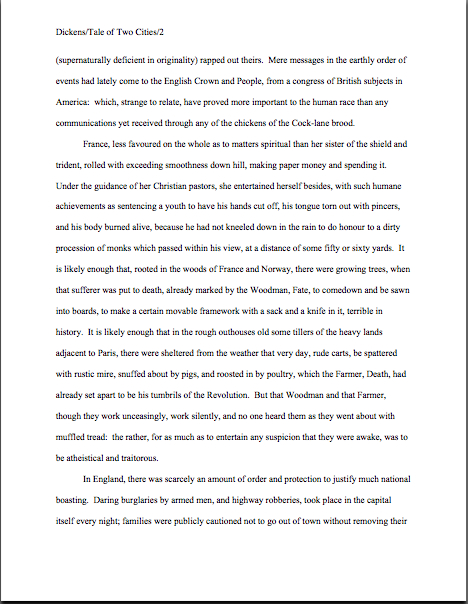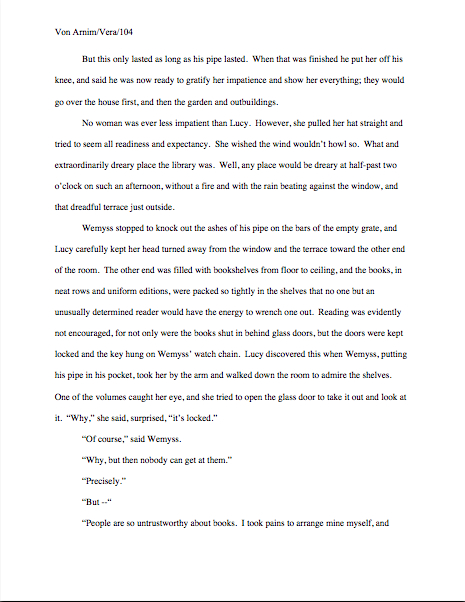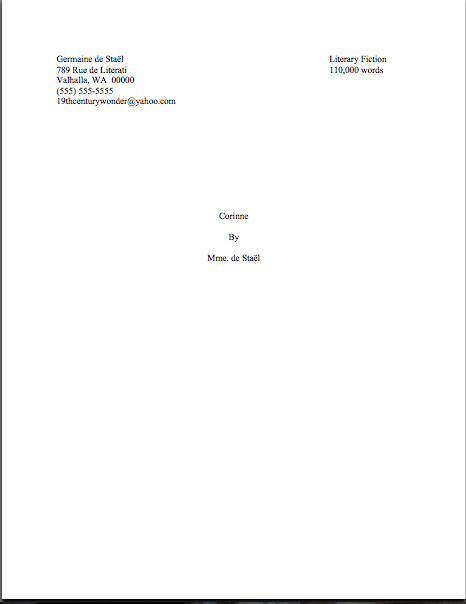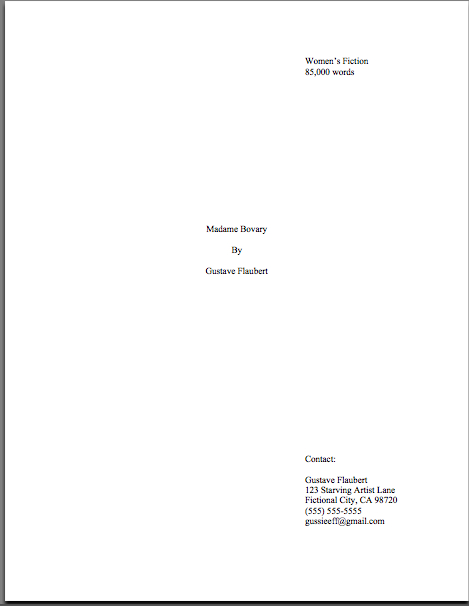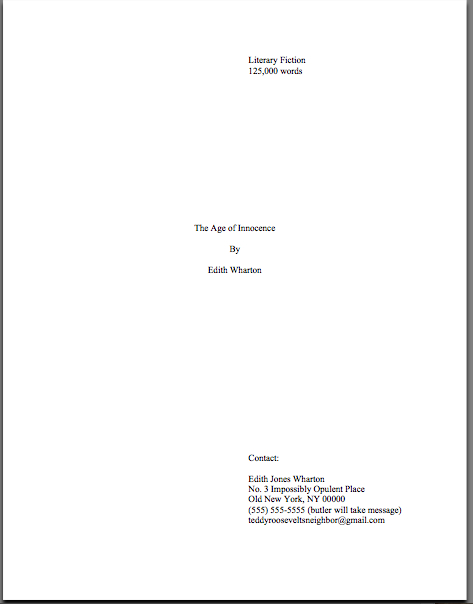Yesterday, I began talking about a series of questions that trouble aspiring writers the world over in the dead of night, at least those who have submitted (or are planning to submit) requested materials to agents. Since no one, but no one, is better at coming up with complicated scenarios with which to while away the insomniac hours than a truly talented writer (novelists are particularly gifted at it, I notice), I shall not even pretend to come up with a complete list of these burning midnight issues, but some of the more popular ones include:
(1) Is it ever okay to submit a manuscript without a direct request from an agent?
(2) Now that I have a direct request from an agent to submit the first 50 pages, may I send the first 52, since that’s the end of that chapter and it contains a really nifty cliffhanger?
(3) I got that request to submit materials an awfully long time ago. May I still send them, or has the agent forgotten all about me and my book?
(4) Now that I have gotten my act together and sent those requested materials, how soon will I hear back?
(5) It feels like months since I sent those requested materials, but consulting my handy calendar, I see that it’s only been a few weeks. Should I read something into the fact that I haven’t heard back yet from the agent of my dreams?
(6) Now that it’s been a couple of months since I sent those pages, is it time yet to start reading something into the delay in hearing back?
(7) Now that it’s been several months since I sent those pages, which of the fourteen scenarios I have constructed in my mind about why I haven’t yet heard back is the correct one?
(8) Now that it’s been half a year since I sent those pages, am I even positive that the agent of my dreams received them in the first place? Will I insult her if I ask at this juncture? Or have I already waited too long?
This list goes on and on, of course, but you’re seeing a general trend here, right? No matter what course the aspiring writer chooses, until it’s been validated by a “Hey, I would LOVE to represent you!” call from an agent, it can cause worry, if not outright self-flagellation, in the night: am I about to do the right thing? Have I done the right thing? How will I know if I’ve done the right thing?
Now, if I were a bossier sort of person, or one who regarded the literary world as simple, straightforward, and run according to a monolithic set of rules to which every agent in North America swore a blood oath to uphold through storm and tempest, I might be tempted to soothe writerly worries by short, dogmatic, one-size-fits-all answers on the order of:
(1) No.
(2) No.
(3) Yes.
(4) Whenever the agent gets around to it.
(5) No.
(6) No, not until twice the length of time the agency states as its average has passed. Then, and only then, may you follow up.
(7) In all probability, none of them.
(8) Wait — you haven’t checked by now?
Terse, isn’t it? Pronouncements based upon the prevailing wisdom often are — and are seldom, I have found, very comforting (or even all that enlightening, in many instances) to the living, breathing human being troubled by Questions 1-8.
Now, admittedly, brevity has never been the soul of my wit. As long-term readers of this blog are no doubt clock-watchingly aware, I often spend an entire post, or even an entire series, on even a single one of these types of questions. Since the literary market is in constant flux, especially lately, I like to give my readers as much of the logic behind the prevailing wisdom as possible.
And if you doubt that, feel free to check out the archived posts in any of the 194 categories ont he list at right. No one can say that I don’t like to cover bases THOROUGHLY.
As it happens, none of Questions 1-8 is the subject of today’s base-covering. However, since I’ve gotten you worrying about them, here are some less-terse answers:
(1) Not unless the agency has posted submissions on its website or in its listing in one of the standard agency guides asking for queriers to include certain materials with their query letters. Technically, though, this is not a requested submission; it just means that the agents at that particular agency like to have a bit more evidence in front of them before they decide to reject a query or ask to see a manuscript.
(2) I wouldn’t advise it, since sending more than the agent requested sends the message that the submitter can’t follow directions very well. The way an experienced submitter (or contest entrant) handles this dilemma is to revise the submission pages so that the nifty cliffhanger ends up on p. 50; after all, one can always revise it back to the original length after the agent asks to see the rest of the book. (Cynical, perhaps, but hardly an uncommon practice.)
(3) It depends what you mean by a really long time ago. Speaking of thoroughness, please see yesterday’s rather lengthy blog post for elaboration (and many, many reiterations of it depends.)
(4) It depends upon how many submissions the agent and her screeners happen to be processing at the moment, but 6-8 weeks is fairly average for a mailed submission; check the agency’s website and/or agency guide listing to see what they say their turn-around time usually is. E-mailed submissions often experience speedier turn-around times, but anecdotal evidence implies that they’re also more likely to be rejected than a physical submission.
(5) It probably isn’t in your interest to do so, because agencies do get backlogged. If you haven’t heard back, chances are that it’s because no one at the agency has read it yet. Relax, have a nice cup of tea — then send out ten more queries, to hedge your bets.
(6) After a couple of months, you should probably check with the agency to make sure that they actually received your submission; if they didn’t, or if they have lost it, they usually want to know. Phrase the follow-up as politely as possible (vindictive statements implying that they should have gotten back to you weeks ago tend not to play well), but do follow up.
(7) In all probability, none of them is a pretty good response, actually, but I don’t think that it addresses the underlying issue here, which concerns how long a writer should wait for a response. Once the months have started to add up, the most productive way to spend your energy is (a) double-checking that the agency has indeed received your submission, if you have not already done so, (b) triple-checking that the agency doesn’t have a policy that no news = rejection (some do; check their websites), and/or (c) querying and submitting to other agents.
(8) It really isn’t a good idea to wait as long as six months to follow up on your submission unless the agency states point-blank that its turn-around times are genuinely that long. You are perfectly free to ask for an update, but at this juncture, the people who handled the submission probably will not remember it. Ask politely for information, but don’t hold your breath, awaiting a response: move on.
Philosophically, I notice a common thread running through many of these questions, an anxiety that I’ve crop up with astonishing frequency amongst writers of my acquaintance over the years. Frankly, it keeps me up at night, worrying about writers who have fallen prey to it.
It’s a syndrome that, in its mild form, can drive writers to lose confidence in their work after only a few queries, and in its most virulent form, can alienate agents and editors before they’ve even read a word that the writer has penned. And, to make it harder to head off at the pass, or to diagnose before symptoms develop, this syndrome leads to behavior in which a professional writer, one who was actually making a living at it, would never even consider engaging.
So, naturally, until I started teaching marketing classes to writers and hanging out at conferences, it had never occurred to me that writers I know, good ones with probably quite bright futures, were engaging in it — and that this syndrome might conceivably be harming their publication prospects, as well as their nightly rest.
So today I’m going to flag it, so none of my dear readers get caught in this quite common trap.
I refer, of course, to the notion that ANY book by a first-time author — be it absolutely the latest word in literary fiction, the mystery that even Perry Mason couldn’t solve before page 355, or the proverbial next DA VINCI CODE — would be so exciting to agents and editors that they would drop everything else to pay attention to it the nanosecond its pages first breathe agency air.
Or, potentially even more damaging, that a submission SHOULD receive that level of attention, and that the writer has a right to expect instantaneous responses. Or even very quick ones.
Now, I have mentioned the most common corollary to this belief many times before: the insidious idea that if a book is really good (or, more usually, if its writer is truly talented), that the first query, the first pitch, the first submission will instantly traject it into a cozy lifetime relationship with the perfect agent or editor.
Oh, those of you with extensive querying and submission experience may laugh, but deep down, let’s face it — most of us would love to believe that our work is so redolent with talent that it will be the exception to the long turn-around time norm.
The fantasy is a compelling one: place a stamp on a query on Monday, receive a request for the full manuscript by the end of the week, sign before a fortnight has elapsed, sell to a prominent publisher by Arbor Day. For those who query via e-mail, the expected timeline runs even faster: query tonight, request tomorrow, sign by next Wednesday, sale by April Fool’s Day.
I wish I could tell you it could happen, but as long-time readers of this blog already know, the industry just doesn’t work that way. Occasionally, one querier out of a million may strike lucky, but a good writer should EXPECT to have to try many agents before being signed, and to have to wait weeks or even months to hear back from agents and editors.
Yes, you did indeed read that correctly: I’m saying, in the nicest and most supportive way I possibly can, that most queriers and submitters don’t have particularly realistic expectations about how the industry is going to treat their work. Since unrealistic expectations can give rise to a whole lot of grief, worry, and doubt about one’s talent, would anyone mind if I suggest, gently, that one of the best holiday presents an aspiring writer could possibly give herself is a rather depressing long, hard look at the actual norms of the biz?
Just a suggestion.
Before anyone out there gets defensive, let me hasten to add that there are a number of excellent reasons that writers might have unrealistic views of how new talent is received — the most pervasive and best being that, as we have discussed before, the general public tends to harbor a pretty rosy vision of how a first book typically comes to publication.
Often, this vision specifically includes the approval of the inimitable Ms. Oprah Winfrey, the New York Times Book Review, and the Today Show. Yes, a small proportion of the books released in English every year are indeed celebrated in all of these venues, just as a small proportion the high school seniors who graduate each year are accepted to Harvard.
But is either route the norm? Statistically speaking, not by a long shot — so wouldn’t it make more sense to examine the treatment of the rest of the books published every year (or the college-admission successes of the rest of any year’s crop of high school graduates, for that matter) in order to understand the system, rather than the exceptions?
The problem is, it can be pretty hard for a writer to find out what the average first-time author’s trajectory to publication actually is. The vast majority of queriers and submitters work in isolation, without the opportunity to see how other writers at their level of recognition are being treated.
Naturally, under those conditions, long turn-around times can start to feel awfully darned personal. (You were wondering when I was going to get back to the topic at hand, weren’t you?) But while the anxiety certainly affects one personally, the factors that cause it are very, very seldom directed at a particular individual.
While you ponder that little paradox, I’m going to move on to the practical implications of not learning what those norms are.
Giving in to the notion that good work gets picked up immediately may cause a writer to take years to cover the requisite array of agents to find the right one, or even to stop querying in frustration after only a few tries.
Strategically, either is a bad idea. In case any of you have missed the other 147 times I’ve said it over the last three years, it just doesn’t make sense to query or submit to agents one at a time, no matter how much a writer happens to like a particular agent. Competition over who is going to represent you, like competition over who is going to publish your book, can only help you.
Besides, as I MAY have mentioned here in the past (or past couple of days), unless an agent asks you point-blank for an exclusive peek at a manuscript or a writer chooses to approach an agency with an exclusives-only policy, these days, most agents ASSUME that a writer is sending out simultaneous submissions.
The larger assumption, the one that dictates an expectation that ANY book is a drop-my-other-hundred-projects occasion for an agent or editor, is even more dangerous, because — you might want to pour yourself a drink before reading the rest of this sentence; I’ll wait — as anyone in the industry can tell you, there is no manuscript for which every agent is holding his breath.
Oh, naturally, everyone would like to snap up the next bestseller, of course, but since no one really knows what that will be — particularly in this troubled and rapidly-changing book market — and they spend their lives surrounded by so much paper that the average agency could use it for insulation seventeen times over, it would simply be too exhausting to leap upon each new submission as though it contained the philosopher’s stone.
Yes, even if that book ultimately turns out to be HARRY POTTER AND THE PHILOSOPHER’S STONE.
What does this mean for the submitters we saw gnawing their fingernails to the quick at the beginning of this post? I hate to be the one to break it to them, but they need to be patient.
Agents need time to read, and no matter how much any given writer would like his to be the only submission on his dream agent’s desk at any given moment, his is probably going to be one of fifty. Or a hundred.
So there can be no legitimate reason, in their minds, for a writer to act as if his book is THE one. Even if it is. It’s just not good for a writer’s health, happiness — or even, in some instances, his long-term career prospects.
Don’t believe me? Here’s a parable.
Marcel has been working on his novel for a decade. Finally, after showing it timorously to his lover, his mother, and a couple of rouès claiming to be artistes he met at the corner cafè (not in that order), he decides it is ready to submit to agents. Being a careful sort of person, he researches agencies, and finally settles on the one that represents his favorite writer.
He submits his work, fully expecting to hear back within the week. By the end of a month, he is both flabbergasted and furious: why hasn’t that agent gotten back to him?
As the sixth week ticks by, he decides that there is no point in hoping anymore. When his SASE and manuscript finally arrive back on his doorstep at the beginning of week 9, he doesn’t even bother to open the packet. He pitches them straight into the recycling bin.
He never submits again. Instead, he hangs out in absinthe bars with his amis, bemoaning the fact that the publishing world has refused to see his genius.
Okay, where did Marcel misstep here? (Other than drinking absinthe, which I’m told is pretty lethal.)
Oh, let me count the ways. Give yourself an A if you said he assumed that a single agent’s reaction was identical to that of everyone’s in the publishing world, as if rejection once means rejection eternally. What does Marcel think, that every agent in the country gets together every night under the cover of dark to share the day’s submissions, so every agent can provide a uniform response?
(Actually, there is a pervasive rumor like this that surfaces on the conference circuit every year or two about a national database where agents log in the names and book titles of every rejection, so that once a manuscript has been seen by a couple of agents, the others will know to avoid it. Piffle.)
An unsympathetic observer might conclude that Marcel’s belief that one agent equaled the industry actually stemmed not from insecurity, but from an extreme case of egoism on Marcel’s part. Rather than considering himself one of the literal millions submitting manuscripts each year, or pondering the notion that he might need to learn a bit more about the industry before he can submit successfully, he prefers to conclude that his IDEAS are too out there for the cowardly market.
At least, he concludes that aloud: in his heart, he may actually believe that no one is interested in what he has to say. In this, he would be far from alone: there are plenty of Marcels out there who never send their books out even once.
Was that great collective “OH!” I just heard indicative of realizing that you know a writer like Marcel? Most of us do. The Marcels of the world are the ones who are all talk, and no query.
It takes real guts to pick yourself up after a rejection and send your work out again. It’s mighty tempting to give up, isn’t it? So give yourself an A+ if you pointed out by giving up so easily, Marcel never has to risk his ego’s being demolished by rejection again.
Extra credit with a cherry on top if you noticed that Marcel sought feedback only from his lover and friends, who could not possibly give him unbiased critique.
A sympathetic observer might have reached a different conclusion: Marcel believed so deeply in the notion that good writing is always picked up immediately that his faith in his talent was utterly, completely crushed by the very first rejection. He thought it meant something that it most emphatically did not: a message from every professional reader in the world that he should never have tried to sell his work in the first place. His subsequent bluster, then, is a bold attempt to pretend that he wasn’t hurt as deeply as he actually was.
Which is the more likely explanation for any of the individual Marcels each of us might happen to know? Beats me; only they know for sure. All I know is that when I meet someone like this, my first thought is, “Oh, I’m so sorry that you’ve given up on your dream.”
I didn’t bring Marcel to your attention to make you feel sorry for him, however, but to remind you that you’re too clever and brave to follow Marcel’s route in any of those respects, aren’t you?
For the sake of my much-needed good night’s sleep, please tell me that you are. You know that a single rejection cannot logically mean that the book is unmarketable, that your writing is no good, or that you should give up writing altogether. Even a dozen rejections do not necessarily mean that, nor do a hundred.
What an individual rejection means is that the agency in question didn’t like something about the submission. Period.
Try to improve your submissions, by all means, but keep trying. Having to send out your work again and again is not — I repeat, is NOT — necessarily a reflection upon the quality of your writing, although it often is a reflection of how it is presented on the page. (Thus my continual yammering on the joys of standard format.)
I mention all of this not to depress you, but to plant a seed that I hope will germinate when some of you are staring at the dark ceiling over your beds, worrying about just what’s happening with your submissions. An agent’s being slow to respond has nothing to do with you or your submission, in all probability, and everything to do with the fact that agencies are up to their gills in manuscripts. Not to mention the fact that the latest news from the big publishing houses is unavoidably pretty darned frightening to those who make a living selling other people’s books.
So please try not to take it personally. Please, please don’t mistake the normal operations of a busy workplace for a referendum on your talent. And please, please, PLEASE don’t give up on a good book because finding an agent for it takes a long time.
Admittedly, the waiting is hard to take; so is the inevitable rejection before one gets to yes. But in the end, isn’t taking that chance worth it?
Yes, being one of that happy (if frequently stressed-out) minority of human beings born with the gifts of acute observation and graceful self-expression, of the smaller subsection of that legion with the stick-to-itiveness to bring a book to completion, or of the even tinier sub-subgroup with the tenacity to, as much-rejected-before-she-hit-the-YA-bestseller list Louisa May Alcott wrote, “make a battering-ram of my head, and make my way through this rough-and-tumble world” of publishing frequently isn’t easy. A lot of us lose a lot of sleep over it. But that’s the price we pay for engaging in what I believe is the highest expression of the human spirit.
Keep your chins up, campers: humanity would be, if not actually lost, at least far less interesting without you. And keep up the good work.




















